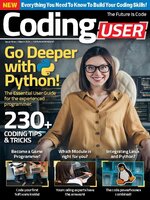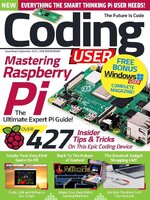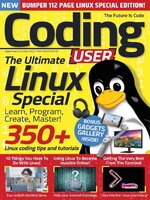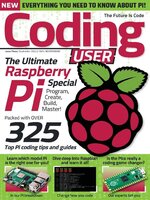Within Coding User, our team of industry experts and professional coders cover all the tools you need to get coding. From those first few lines of code that will change your world forever to insider tips and tricks to advance your skills and programming abilities. Each issue features up-to-date user tutorials, put together in an easy to follow step-by-step manner, building to create a multi-volumed series that will see you get to grips with code but also improve your knowledge, job prospects, and expand your horizons. Let’s get coding, where the only limit is your own imagination. Subscribe today! 100% Independent! Please note: ALL free content and gifts are also available via this digital edition.
Coding USER
Setting Up C++
How to Set Up C++ in Windows • Windows users have a wealth of choice when it comes to programming in C++. There are loads of IDEs and compilers available, including Visual Studio from Microsoft. However, in our opinion, the best C++ IDE to begin with is Code::Blocks.
How to Set Up C++ on a Mac • To begin C++ coding on a Mac you can use Apple’s own developer platform: Xcode. This is a free, full featured IDE that’s designed to create native Apple apps. However, it’s also able to be used to create C++ code relatively easily.
How to Set Up C++ in Linux • Linux is a great C++ coding environment. Most Linux distros already have the essential components preinstalled, such as a compiler and the text editors are excellent for entering code into, including colour coding; there’s also tons of extra software available to help you out.
Other C++ IDEs to Install • If you want to try a different approach to working with your C++ code, then there are plenty of options available to you. Windows is the most prolific platform for C++ IDEs but there are plenty for Mac and Linux users too.
Setting Up Python
How to Set Up Python in Windows • Windows users can easily install the Python programming language via the main Python Downloads page. While most seasoned Python developers may shun Windows as the platform of choice for building their code, it’s still an ideal starting point for beginners.
How to Set Up Python in Linux • While the Raspberry Pi’s operating system contains the latest, stable version of Python, other Linux distros don’t come with Python 3 pre-installed. If you’re not going down the Pi route, then here’s how to check and install Python for Linux.
Python on the Pi • If you’re considering on which platform to install and use Python, then give some thought to one of the best coding bases available: the Raspberry Pi. The Pi has many advantages for the coder: it’s cheap, easy to use, and extraordinarily flexible.
Your First Linux Coding Project
Installing Linux in a Virtual Environment • With Oracle’s VirtualBox now up and running, the next task is to create the Virtual Machine (VM) environment into which you will install Linux. This process won’t affect your currently installed operating system, which is why a VM is a great choice.
Getting Ready to Code in Linux • Coding in Linux mostly happens in the Terminal or the Command Line. While it can be a scary looking place to begin with, the Terminal is an extremely powerful environment. Before you can start to code, it’s best to master the Terminal.
DID YOU KNOW? • Space Rocket Destroyed by a Coding Error
Creating Bash Scripts – Part 1 • Eventually, as you advance with Linux Mint, you’ll want to start creating your own automated tasks and programs. These are essentially scripts, Bash Shell scripts to be exact, and they work in the same way as a DOS Batch file does, or any other programming language.
Creating Bash Scripts – Part 2 • Previously we looked at creating your first Bash script, Hello World, and adding a system variable. Now you can expand these and...

 Vol 9 2024
Vol 9 2024
 Vol 8 2023
Vol 8 2023
 Vol 7 2023
Vol 7 2023
 Vol 6 2023
Vol 6 2023
 Vol 5 2023
Vol 5 2023
 Vol 4 2022
Vol 4 2022
 Vol 3 2022
Vol 3 2022
 Vol 2 2022
Vol 2 2022
 Vol 1 2022
Vol 1 2022
